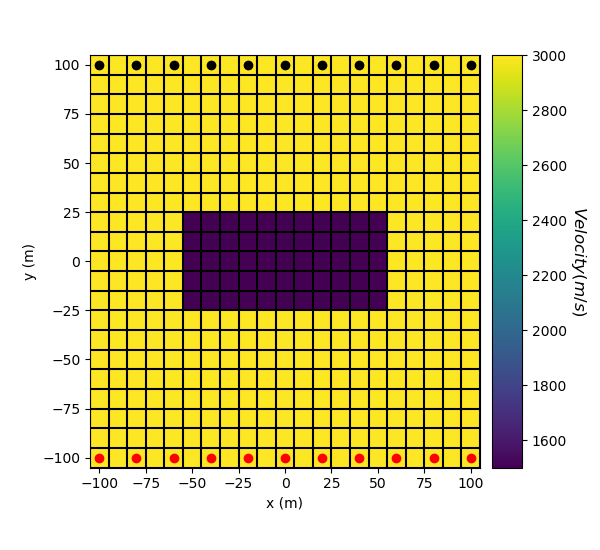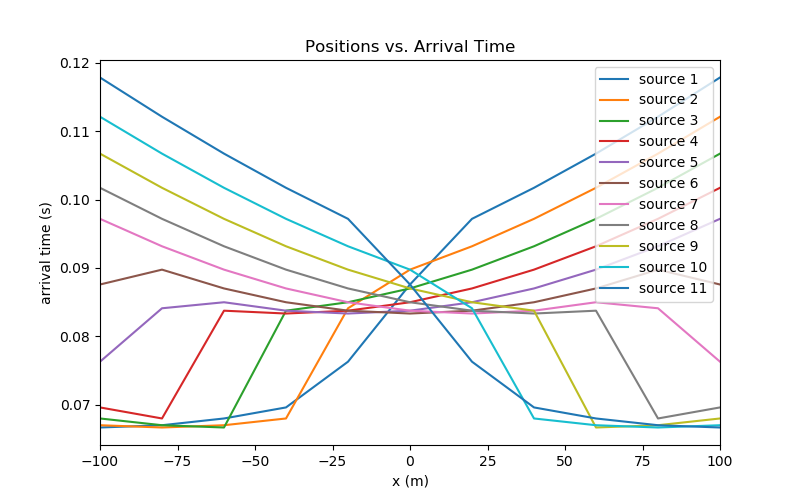Note
Click here to download the full example code
Forward Simulation for Straight Ray Tomography in 2D¶
Here we module SimPEG.seismic.straight_ray_tomography to predict arrival time data for a synthetic velocity/slowness model. In this tutorial, we focus on the following:
How to define the survey
How to define the forward simulation
How to predict arrival time data
Import Modules¶
import os
import numpy as np
import matplotlib as mpl
import matplotlib.pyplot as plt
from discretize import TensorMesh
from SimPEG import maps
from SimPEG.seismic import straight_ray_tomography as tomo
from SimPEG.utils import model_builder
save_file = False
Defining the Survey¶
Here, we define survey that will be used for the forward simulation. The survey consists of a horizontal line of point receivers at Y = 100 m and a horizontal line of point sources at Y = -100 m. The shot by each source is measured by all receivers.
# Define the locations for the sources and receivers.
x = np.linspace(-100, 100, 11)
y_receivers = 100 * np.ones(len(x))
y_sources = -100 * np.ones(len(x))
receiver_locations = np.c_[x, y_receivers]
source_locations = np.c_[x, y_sources]
# Define the list of receivers used by each source
receiver_list = [tomo.Rx(receiver_locations)]
# Define an empty list to store sources objects. Define each source and
# provide its corresponding receivers list
source_list = []
for ii in range(0, len(y_sources)):
source_list.append(
tomo.Src(location=source_locations[ii, :], receiver_list=receiver_list)
)
# Define they tomography survey
survey = tomo.Survey(source_list)
Defining a Tensor Mesh¶
Here, we create the tensor mesh that will be used to predict arrival time data.
Model and Mapping on Tensor Mesh¶
Here, we create the velocity model that will be used to predict the data. Since the physical parameter for straight ray tomography is slowness, we must define a mapping which converts velocity values to slowness values. The model consists of a lower velocity block within a higher velocity background.
# Define velocity of each unit in m/s
background_velocity = 3000.0
block_velocity = 1500.0
# Define the model. Models in SimPEG are vector arrays.
model = background_velocity * np.ones(mesh.nC)
ind_block = model_builder.getIndicesBlock(np.r_[-50, 20], np.r_[50, -20], mesh.gridCC)
model[ind_block] = block_velocity
# Define a mapping from the model (velocity) to the slowness. If your model
# consists of slowness values, you can use *maps.IdentityMap*.
model_mapping = maps.ReciprocalMap()
# Plot Velocity Model
fig = plt.figure(figsize=(6, 5.5))
ax1 = fig.add_axes([0.15, 0.15, 0.65, 0.75])
mesh.plotImage(model, ax=ax1, grid=True, pcolorOpts={"cmap": "viridis"})
ax1.set_xlabel("x (m)")
ax1.set_ylabel("y (m)")
ax1.plot(x, y_sources, "ro") # source locations
ax1.plot(x, y_receivers, "ko") # receiver locations
ax2 = fig.add_axes([0.82, 0.15, 0.05, 0.75])
norm = mpl.colors.Normalize(vmin=np.min(model), vmax=np.max(model))
cbar = mpl.colorbar.ColorbarBase(
ax2, norm=norm, orientation="vertical", cmap=mpl.cm.viridis
)
cbar.set_label("$Velocity (m/s)$", rotation=270, labelpad=15, size=12)

Simulation: Arrival Time¶
Here we demonstrate how to predict arrival time data for the 2D straight ray tomography problem using the 2D Integral formulation.
# Define the forward simulation. To do this we need the mesh, the survey and
# the mapping from the model to the slowness values on the mesh.
simulation = tomo.Simulation(mesh, survey=survey, slownessMap=model_mapping)
# Compute predicted data for some model
dpred = simulation.dpred(model)
Plotting¶
n_source = len(source_list)
n_receiver = len(x)
dpred_plotting = dpred.reshape(n_receiver, n_source)
fig = plt.figure(figsize=(8, 5))
ax = fig.add_subplot(111)
obs_string = []
for ii in range(0, n_source):
ax.plot(x, dpred_plotting[:, ii])
obs_string.append("source {}".format(ii + 1))
ax.set_xlim(np.min(x), np.max(x))
ax.set_xlabel("x (m)")
ax.set_ylabel("arrival time (s)")
ax.set_title("Positions vs. Arrival Time")
ax.legend(obs_string, loc="upper right")

Out:
<matplotlib.legend.Legend object at 0xd24454c18>
Optional: Exporting Results¶
Write the data and true model
if save_file:
dir_path = os.path.dirname(tomo.__file__).split(os.path.sep)[:-3]
dir_path.extend(["tutorials", "seismic", "assets"])
dir_path = os.path.sep.join(dir_path) + os.path.sep
noise = 0.05 * dpred * np.random.rand(len(dpred))
data_array = np.c_[
np.kron(x, np.ones(n_receiver)),
np.kron(y_sources, np.ones(n_receiver)),
np.kron(np.ones(n_source), x),
np.kron(np.ones(n_source), y_receivers),
dpred + noise,
]
fname = dir_path + "tomography2D_data.obs"
np.savetxt(fname, data_array, fmt="%.4e")
output_model = model
fname = dir_path + "true_model_2D.txt"
np.savetxt(fname, output_model, fmt="%.4e")
Total running time of the script: ( 0 minutes 8.726 seconds)